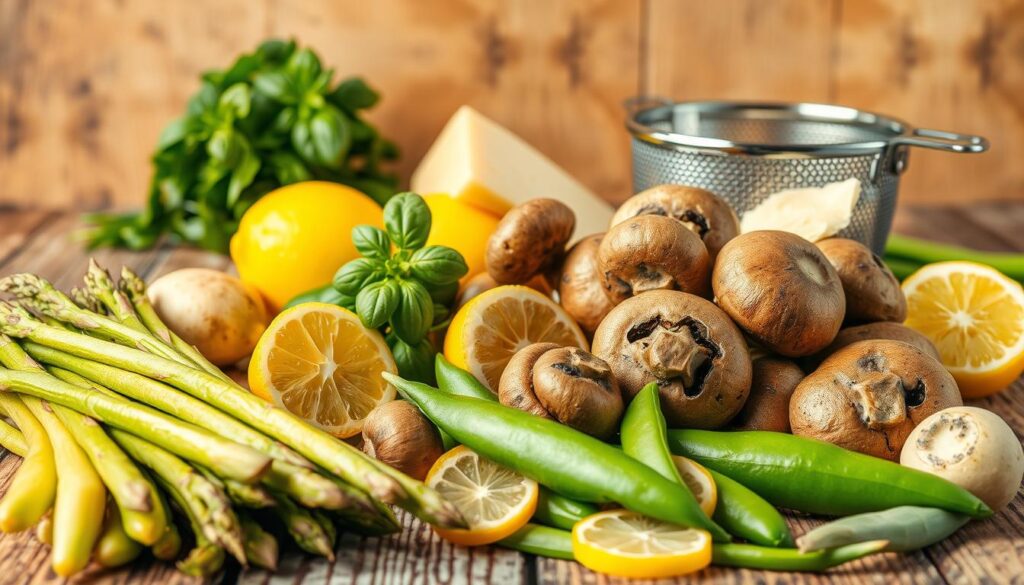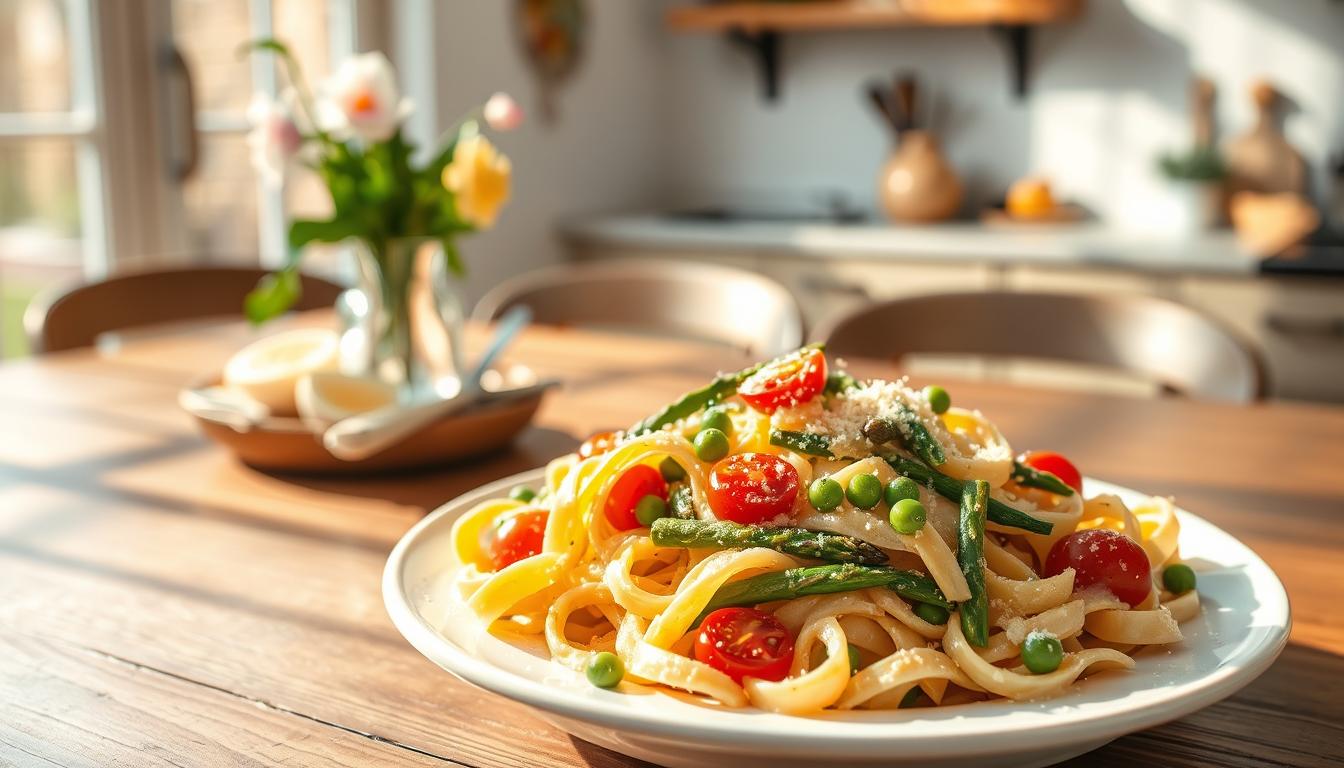Table of Contents
Every spring, my kitchen turns into a colorful place of fresh veggies and new recipes. When asparagus and peas arrive, I start making my favorite pasta primavera. It’s more than food; it’s a celebration of the season’s bounty.
Pasta primavera is a journey through spring’s flavors. It mixes fresh veggies with a creamy sauce. It’s perfect for family dinners or a light meal you’ll love.
Picture twirling pasta with fresh veggies and a zesty sauce. That’s pasta primavera’s magic. It turns simple ingredients into a special meal.
Key Takeaways
- Pasta primavera is the ultimate spring-inspired pasta dish
- Fresh seasonal vegetables are the star of this recipe
- Perfect for family dinners and casual gatherings
- Easily customizable with different vegetables and proteins
- Can be prepared in under 30 minutes
The History and Origins of Pasta Primavera
Pasta primavera became a big hit in American cooking. It mixed Italian cooking with American creativity. This happened in New York City’s kitchens in the 1970s.
At Le Cirque restaurant, Sirio Maccioni created a dish that changed dining forever. He made it during a vacation, answering a need for light, veggie-based meals.
Birth at Le Cirque
In the mid-1970s, pasta primavera made a big splash. The first recipe used fresh veggies like:
- Broccoli
- Zucchini
- Asparagus
- Green beans
- Peas
Evolution into a Modern Classic
Soon, pasta primavera became a favorite at home. The New York Times published the recipe in 1975. This made it a staple in American cooking.
| Decade | Culinary Significance |
|---|---|
| 1970s | Restaurant Fine Dining |
| 1980s | Mainstream Home Cooking |
| 1990s-Present | Personalized Vegetable Variations |
Cultural Impact on Italian-American Cuisine
Pasta primavera is more than a dish. It shows the creativity of Italian-American cooking. It uses fresh veggies and traditional pasta methods, showing how American tastes have changed.
A celebration of spring on a plate, transforming simple ingredients into a culinary masterpiece.
Essential Ingredients for the Perfect Pasta Primavera
To make a great seasonal pasta dish, you need the right ingredients. Your pasta primavera will start with a mix of fresh veggies and quality pantry items.
The key ingredients for a real pasta primavera are:
- Fresh veggies like cherry tomatoes, zucchini, and corn
- 12 oz of fusilli or similar pasta shape
- Extra-virgin olive oil
- Pecorino Romano cheese
- Fresh herbs such as basil
- Pine nuts for added texture
For the best taste, pick peak-season produce. This mix of roasted veggies and cooked pasta makes a light dish that celebrates fresh ingredients.
Your veggie choices can be:
- Cherry tomatoes (1¼ lbs)
- Zucchini cut into chunks
- Fresh corn kernels
- Shallots
- Garlic cloves
Pro tip: Roasting veggies at 450°F makes them sweeter and adds flavor. Roast for 15-20 minutes to get them caramelized just right.
Choosing fresh, quality ingredients and using the right cooking methods will make a tasty pasta dish. It will show off the beauty of seasonal cooking.
Choosing the Right Pasta for Your Primavera
Starting with the right pasta shape is key to a great primavera. The pasta you pick can change how the dish feels in your mouth. Each type of pasta adds its own special touch to your primavera, making choosing it a fun and important step.
Short pasta shapes are perfect for primavera. Here are some top picks:
- Penne: A classic primavera pasta with ridged texture
- Farfalle: Butterfly-shaped pasta that catches sauce beautifully
- Rigatoni: Tubular shape perfect for holding vegetable bits
- Orecchiette: Ear-shaped pasta that cradles vegetables
- Fusilli: Spiral pasta that traps sauce in its twists
Long Pasta Alternatives
Long noodles can also be great in pasta primavera. Spaghetti, angel hair, and fettuccine are elegant choices for a different look.
Mastering Al Dente Cooking
The secret to amazing primavera pasta is cooking it al dente. This means it’s tender but still has a bit of chew. Most pasta takes 6-7 minutes to cook just right.
“Perfect pasta is about texture – not too soft, not too firm.” – Italian Cooking Wisdom
Gluten-Free Pasta Solutions
Even with dietary restrictions, you can still enjoy primavera. Great gluten-free options include:
- Chickpea pasta
- Brown rice pasta
- Quinoa pasta
- Lentil pasta
Go for a gluten-free pasta that keeps its texture well when cooked. It should also match well with your vegetable mix. Each gluten-free pasta has its own taste, adding something special to your dish.
Fresh Spring Vegetables: The Heart of Primavera

Pasta primavera celebrates the vibrant world of spring vegetables. It turns a simple dish into a colorful feast. “Primavera” means “spring” in Italian, making it a perfect tribute to the season’s freshest produce.
To make your pasta primavera special, focus on a mix of vegetables. They add nutrition and flavor to your meal. Here are the top picks:
- Zucchini
- Yellow Squash
- Broccoli
- Carrots
- Bell Peppers
- Cherry Tomatoes
- Asparagus
- Peas
For a great pasta primavera, keep the veggies crisp and colorful. Cook them for just 1-2 minutes. This keeps their nutrients and taste fresh.
| Vegetable | Quantity | Preparation |
|---|---|---|
| Broccoli | 1-1.5 cups | Cut into small florets |
| Carrots | 2 medium | Julienned or sliced |
| Zucchini | 2 medium | Sliced into thin moons |
| Bell Peppers | 1-2 | Sliced into matchsticks |
Choose the freshest, most colorful veggies for your pasta primavera. Mixing different colors makes it look amazing and adds nutrients. Your dish will be as stunning as it tastes!
Creating the Signature Lemon Parmesan Cream Sauce
Making the perfect lemon Parmesan cream sauce turns your vegetable pasta into a light Italian dish. This sauce mixes rich dairy with fresh citrus, making your pasta primavera taste like it’s from a restaurant.
Balancing Cream and Citrus
The secret to a great sauce is balancing creamy and zesty. Start with top-notch ingredients:
- Unsalted butter for a silky base
- Fresh lemon zest for brightness
- Heavy cream for luxurious texture
- Freshly squeezed lemon juice for tang
Incorporating Fresh Herbs
Fresh herbs make your sauce special. Try these herbs:
- Chopped basil for a classic Italian touch
- Finely minced chives for delicate onion notes
- Fresh thyme for earthy undertones
Perfect Sauce Consistency Tips
Getting the right sauce consistency takes patience and skill. Simmer your cream mix slowly, stirring often to avoid lumps. The sauce should stick to the back of a spoon without being too thick or runny.
Pro tip: Warm your ingredients at room temperature to ensure smooth blending and optimal sauce texture.
Step-by-Step Cooking Method
Making the perfect springtime pasta is all about precision and care. Your journey starts with preparing your ingredients and using the right cooking techniques. These steps turn simple ingredients into a delicious meal.
First, gather all your ingredients for this springtime pasta. Make sure your vegetables are chopped and ready before you start cooking.
- Boil salted water for your pasta (recommended 10 ounces of penne)
- Chop vegetables: asparagus, red bell peppers, yellow squash, and carrots
- Heat olive oil in a large skillet over medium heat
- Sauté minced garlic for 30-45 seconds
- Add prepared vegetables, cooking for 5-7 minutes
When cooking your fresh veggie pasta, timing is key. Cook your pasta until al dente, which is usually 8-10 minutes. Also, save 1/2 cup of pasta water for a silky sauce.
“The secret to a perfect primavera is in the balance of vegetables and sauce.” – Professional Chef
To make the cream sauce, mix heavy cream, Parmesan, lemon zest, and pasta water. This makes a rich, vibrant sauce that coats each pasta strand perfectly.
Finally, mix pasta, vegetables, and sauce together. Add fresh basil and red pepper flakes for extra flavor. Your fresh veggie pasta is ready in about 45 minutes.
Seasonal Variations and Vegetable Combinations
Turning your pasta dish into a colorful vegetable masterpiece is simple. Pasta primavera lets you highlight the freshest produce of each season.
Your pasta dish can change a lot with the seasons. Let’s see how to make this classic recipe better with each season’s flavors and nutrients.
Spring and Summer Vegetable Options
In spring and summer, your pasta dish is perfect for light, fresh veggies. Try these combinations:
- Asparagus spears
- Zucchini ribbons
- Cherry tomatoes
- Fresh spring peas
- Tender broccoli florets
- Red bell peppers
Fall and Winter Vegetable Adaptations
As it gets colder, make your pasta dish more filling with winter veggies:
- Roasted butternut squash
- Caramelized Brussels sprouts
- Hearty root vegetables
- Sautéed mushrooms
- Crispy kale chips
- Roasted carrots
Every season brings a new twist to pasta primavera. Mix and match to keep your meals fresh and full of nutrients.
Protein Add-ins and Modifications

Make your pasta primavera more filling by adding protein. Even though traditional pasta is vegetarian, you can add proteins to make it more nutritious. This way, you can please even the hungriest guests.
Here are some tasty protein options for your pasta primavera:
- Grilled Chicken: Lean and flavorful, chicken adds approximately 46g of protein per serving
- Sautéed Shrimp: Provides a delicate seafood twist with high protein content
- Plant-based proteins:
- Chickpeas
- White beans
- Tofu
When adding proteins to your pasta primavera, remember these tips:
- Season proteins lightly to complement vegetable flavors
- Cook proteins separately to maintain texture
- Add proteins at the end to prevent overcooking
“The key is balance – your protein should enhance, not overwhelm, the vibrant vegetable medley.” – Chef Maria Rodriguez
Changing your dish’s nutritional profile can make a big difference. Adding protein can increase calories from 375 to 577 kcal. Protein content goes from 14g to 46g per serving.
Serving and Presentation Tips
Your light italian fare deserves a stunning presentation. It turns primavera pasta primavera into a culinary masterpiece. The right garnishing and plating techniques make every bite a delight.
To make your pasta primavera Instagram-worthy, pay attention to detail. Choose the perfect serving dish that matches your vegetables’ vibrant colors.
Garnishing Techniques
Enhance your primavera pasta primavera with these elegant garnishing methods:
- Sprinkle freshly chopped basil or parsley for a burst of color
- Add a generous dusting of grated Parmesan cheese
- Scatter crushed red pepper flakes for a subtle kick
- Drizzle extra virgin olive oil in a delicate circular pattern
- Garnish with edible flowers for a sophisticated touch
Plating Suggestions
Your plating strategy can elevate a simple dish to restaurant quality. For individual portions, use wide-rimmed white plates. This showcases the colorful vegetables.
When serving family-style, consider a large, shallow pasta bowl. It lets guests see the full array of ingredients.
Pro tip: Twirl the pasta slightly off-center and arrange vegetables artfully around the edges. A final sprinkle of fresh herbs and a lemon wedge will complete your picture-perfect primavera pasta primavera.
Storage and Reheating Guidelines

Keeping your springtime pasta fresh is key. It’s all about how you store and reheat it. With the right steps, your vegetable pasta will stay tasty.
Here’s how to store your pasta primavera:
- Use an airtight container for refrigeration
- Store in the refrigerator for up to 3 days
- Separate sauce from pasta if possible
Reheating your pasta needs gentle care. This prevents it from becoming soggy. Here are some good ways to reheat:
- Microwave Method:
- Place pasta in a microwave-safe dish
- Add 2-3 tablespoons of water or cream
- Cover and heat in 30-second intervals
- Stir between intervals
- Stovetop Method:
- Use a non-stick skillet
- Add a splash of cream or broth
- Reheat on low-medium heat
- Stir continuously to prevent sticking
If you want to keep your pasta longer, freeze it for up to 3 months. To enjoy, thaw it in the fridge overnight. Then, reheat it using the methods above.
Pro tip: Fresh herbs can revive reheated pasta and bring back its original vibrant flavors!
Conclusion
Your journey with pasta primavera shows how versatile this dish is. It started in 1970s New York and now you can make it at home. This recipe lets you be creative and express yourself through food.
It’s easy to make and can change with the seasons. Just 12 oz of penne pasta and colorful veggies like zucchini and cherry tomatoes make a great meal. You can also add spicy red pepper flakes or Mediterranean flavors for a twist.
Your pasta primavera is a reflection of your cooking style and tastes. Use fresh ingredients, try new flavors, and enjoy cooking. Share it with friends and family and make it your own.
Exploring pasta primavera is more than just cooking. It’s celebrating fresh ingredients, creativity, and the joy of cooking. Bon appétit!
FAQ
What exactly is pasta primavera?
Pasta primavera is a dish full of fresh vegetables. It’s made with a light lemon Parmesan sauce. The mix of spring and summer veggies makes it colorful and tasty.
Where did pasta primavera originate?
It was born in the 1970s at Le Cirque in New York City. This dish is a blend of Italian cooking and American tastes.
What are the best vegetables to use in pasta primavera?
Great choices include zucchini, asparagus, and bell peppers. Cherry tomatoes and broccoli are also good. Pick fresh, seasonal veggies for the best flavor and color.
Can I make pasta primavera vegetarian or vegan?
Yes, you can! It’s already vegetarian. For a vegan version, swap dairy cream for plant-based options. Use nutritional yeast instead of Parmesan.
What type of pasta works best for primavera?
Short pasta shapes like penne and farfalle are best. They hold the sauce and veggies well.
How can I add protein to pasta primavera?
Add grilled chicken or sautéed shrimp for protein. Chickpeas, white beans, or tofu also work well. They don’t overpower the veggies.
How long can I store leftover pasta primavera?
Store it in the fridge for 3-4 days. When reheating, add cream or olive oil to keep it moist.
Is pasta primavera a seasonal dish?
Originally for spring, it can be enjoyed all year. Just change the veggies to match the season.
What makes the perfect lemon Parmesan cream sauce?
The sauce should mix creamy richness with lemon’s brightness. Use fresh Parmesan and herbs like basil for extra flavor.
Are there gluten-free options for pasta primavera?
Yes, use gluten-free pasta made from rice, corn, or quinoa. These keep the dish’s texture and taste.

